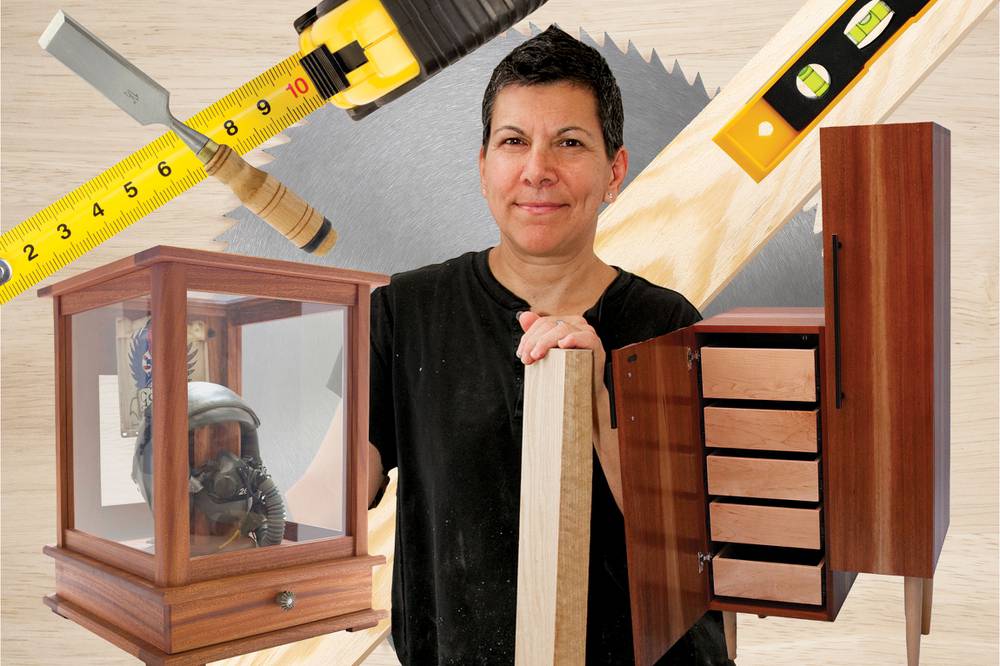In high school, Jamie Yocono was barred from her dream elective. “Back then, girls weren’t allowed to take wood shop,” Yocono recalls. “I thought that was so ridiculous.”
So she struck a deal: If Yocono took home economics—the required course for girls—she could also take wood shop. “From the moment I walked into the wood shop, I knew that’s what I wanted to do for the rest of my life,” Yocono says.
Today, Yocono runs two woodworking businesses in Las Vegas: a school and a custom cabinet studio. Both are called Wood It Is!.
The local demand for woodworking knowledge is so high, Yocono says, her classes are sometimes booked out a year in advance. She’s also the only game in town, referring to herself as “the last woman standing.” Both UNLV and CSN’s woodworking classes go through her shop.
In today’s disposable society, Yocono says the appeal of woodworking stems from its permanence. The projects that she and her students build become family heirlooms. They’re hand-crafted out of solid wood, and made to last. “It’s really rewarding to do it yourself,” Yocono says.
Just be aware that DIY isn’t necessarily cheaper than store-bought. “Some people mistakenly come to my school and they think they’re gonna save money doing it themselves. They’re not,” Yocono says. “It’s gonna cost you more, and your first few pieces may not be as good as you want them to be.”
Yocono cycles through teaching about 30 different class projects, and some eager students try to take them all. “We do everything from tables to bookcases to outdoor furniture to rocking chairs,” Yocono says. “Why wouldn’t you jump at the opportunity to make your own desk or dining room table and chairs?”
The only downside? Thanks to the pandemic-fueled boom in home construction, the price of wood is sky high.
Tools 101
Instead of buying a bunch of tools, Yocono suggests newbies rent time in a fully stocked wood shop. She rents out studio time to those who have completed her basic woodworking course. “[Former students] come back on the weekends and they’re building beds, dining room tables, little rocking chairs for their grandchildren.”
ν Learn before buying tools. Not all tools are created equal, and a lot of tools shown in catalogs and on TV shows are a waste of money, according to Yocono.
ν When you’re ready to buy, splurge on a table saw. You can skimp on other tools, but Yocono says you should construct your wood shop around your table saw. You’ll want something with a lot of capacity and high horsepower. “If you buy a crappy little $200 or $300 table saw, you’re just going to fight it for the rest of your life,” Yocono says. She suggests devoting a third to a half of your total tool budget on a table saw.
ν Choose a quality set of hand tools. Yocono advises buying a nice pair of chisels. Then learn how to sharpen them.
ν You can never have too many clamps. “You’re always clamping something [when you’re woodworking],” Yocono says. “Every time you see clamps, if they’re good ones, buy them.”
Wood It Is! Classes
New students should begin with the beginners woodworking class (tuition $279, materials $120). After that, students may take a variety of classes, such as bookcase making (tuition $279, materials $65).
If you just want to make a quick, fun project, the Pen Turning Class (Tuition + materials $95) could be for you. The three-hour class requires no prior training, and can be fun for family, friends or date nights. At the end, you’ll emerge with your own hand-made wooden pen.
Classes fill up fast, so check woodworkingclassesinlasvegas.blogspot.com for new openings.
Expert Tips
Practice. Before you set out to build that masterpiece bedroom suite, Yocono says, you’ll first need to hone your woodworking skills. For example, start by practicing cutting plywood with a table saw “until you have little shards of wood” to improve your accuracy. And obviously, be careful!
Start simple. Don’t try to make a project that’s outsizes your skill level, Yocono advises.
Make what you need. If you’re struggling to pick a project, Yocono advises looking around your house to see what’s missing. “Coffee tables and end tables are two of the easiest things to build,” she says. She also recommends a wall mirror, a key holder or a desk hutch.
Get handy.Those woodworking skills might also prove useful around the house. “Once you start using the tools to build furniture, you realize that you can fix your kitchen cabinets or you can work on a fence in your yard,” Yocono says.
Personalize it. Once you’ve learned wood cutting and simple joinery, Yocono recommends making your own plans for woodworking projects. “Don’t rely on somebody else to help to tell you the sizes to cut your pieces; personalize it, and make it your own.”




